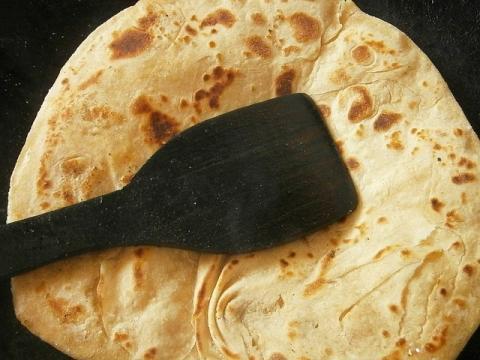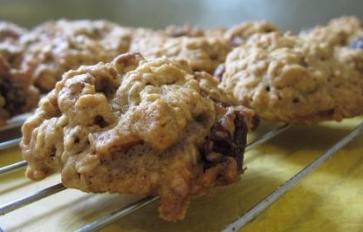
In plain English, a chapati, roti or fulka is pan-roasted unleavened bread. It has been made the same way for hundreds of years and is easy to make, good to eat, full of health benefits and goes with just about everything. Made out of whole wheat flour, a chapati can be made even more nutritious by adding different kinds of flours to the wheat flour dough like gram, soya, millet, barley, sorghum and rye. However, these flours have to be added in small proportions else the chapatis turn too tough and dry to eat. A good ratio is a teaspoon of any other flour to a cup of whole wheat.
Is chapati healthier than bread?
This one is a bit of a conundrum. If you bake bread at home using whole wheat flour and eat it fresh off the rack without adding any preservatives then no, we’d say bread is as healthy as a chapati. But since many of us tend to eat store-bought breads, the chapati wins hands down. Most commercial breads lose the fiber content of the wheat flour – the all-purpose flour used in baking (maida) is overly refined wheat flour with little to no fiber content. The yeast, as well as the preservatives, added into the breads also does not make it healthy to eat. If you are health conscious enough to make organic bread at home, then chapatis could be just a fun world-cuisine thing to cook. But if your home is ruled by commercially bought wheat bread, then maybe you could start making some chapatis to add in more nutrition and health to your table.
The recipe
To make a chapati, you first have to make the dough.
Sift two cups of whole wheat flour into a large flat bowl (in India, to knead the dough we use special copper or steel utensils called paraat). Make a well in the center and add in 1 tsp of olive or coconut oil. This is to make the dough smooth and to prevent it from going rancid too quickly. You will need about ½ to ¾ cup of water – but don’t pour all of it in at once. Start with a splash of water and get your fingers into the dough, basically mixing water and flour into a Play-Doh like consistency. Keep adding splashes of water till all the flour has been converted into malleable dough. Knead further, turning the dough as soft and smooth as possible. You have to use your fingers, your knuckles and the palms of your hands to turn the dough smooth. Once all the flour and water has been mixed, a good 5 minutes of kneading post that will get you soft, smooth chapatis.
To make the chapatis, you will need to keep some loose wheat flour at hand for dusting the dough, a pan or skillet (we make chapatis on cast iron pans or skillets called tawa), a rolling pin (belan) and a clean countertop or the Indian chakla (it’s a small round platform on which chapatis are rolled out).
To make the chapati, put a pan on medium flame and let it heat till it smokes. Turn down the heat. Snip off a small handful of the dough and roll it into a ball between your palms. Now gently press this all into the loose flour and shake off any excess. Start rolling the ball into a circular shape with the rolling pin – the trick is to use gentle, even pressure. Keep rotating the rolled-out dough so that you get a circle instead of an uneven shape. If your attempt at a circle isn’t going too well – a trick I very often use is to cut out a circle using a large bowl or cookie-cutter.
Lay this rolled out dough flat on the hot pan. Let one side cook for about a minute or till you see bubbling on the surface. Using a spatula, flip over the chapati and let it cook on the other side. You’ll see the chapati start to fluff up with air – when cooked, the dough forms an air pocket in between. You can use a kitchen towel, or even an oven mitt to gently press the chapati till it rises evenly everywhere. Remember that the “air” inside the chapati is steam, so keep your hands protected from the heat while fluffing it up further. Transfer the now cooked chapati to a casserole dish lined with paper towels to keep it warm and prevent it from getting soggy. Each chapati should take about 2-3 minutes to make and the more you make, the better you’ll get at it.
Serving Ideas & Tips
Traditionally speaking, Indians serve chapati with sabzi or bhaji, basically cooked vegetable curries, stews and stir-fries as well as with chicken and meat curries. The great thing about a chapati is that it’s very adaptable; you can serve it with just about anything.
You can serve it on the side, or turn it into a roll. Chapatis also make great snacks for children and can be served with anything, as it is a bread slice. Peanut butter & jelly, jam, salted butter, Nutella, even gooey mozzarella or flavorful cheddar – you can spread just about anything over a chapati and roll it up to eat. And the great thing about chapatis over bread is that chapatis don’t leave any crumbs!
Of course, to every end there’s a means. And if kneading the dough and pan-roasting the chapatis sound like too much work – try buying a Kitchen Aid mixer to make the dough and an electric roti or tortilla maker to make the perfect rotis. About the same result, with half the work!
And if you ended up making too many, here’s what to do with leftover chapatis or rotis.
We hope you enjoy the recipe and make the perfect chapati. Do write in about your chapati tales in the comments section below, and feel free to post any questions as well…








